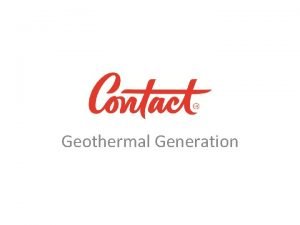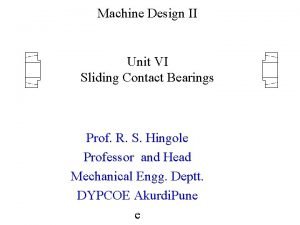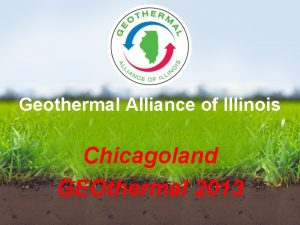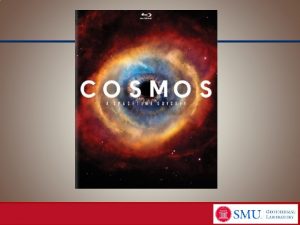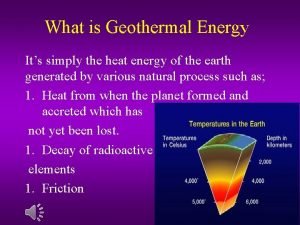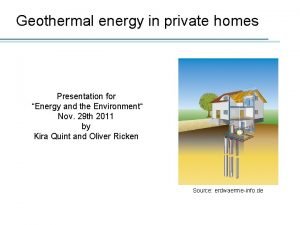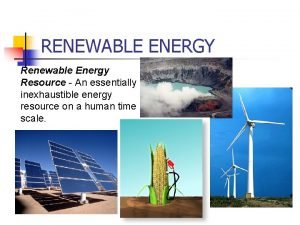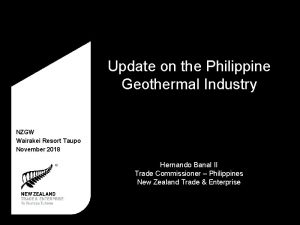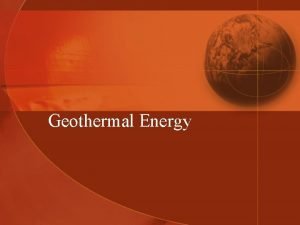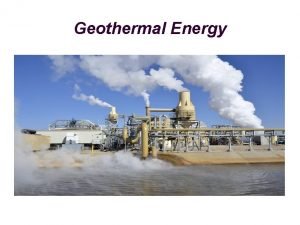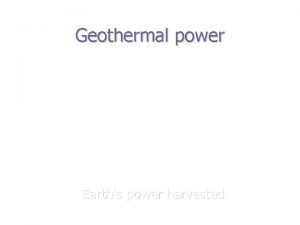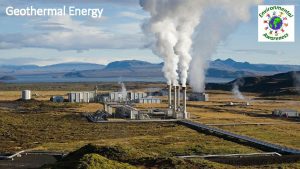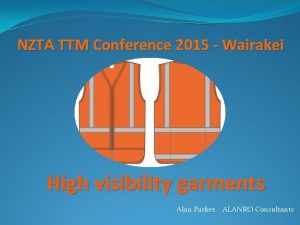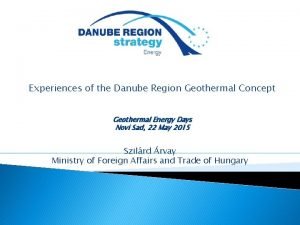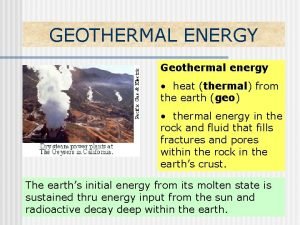Geothermal Generation Contact Geothermal 2 Wairakei Tauhara Geothermal



















- Slides: 19

Geothermal Generation

Contact Geothermal 2

Wairakei –Tauhara Geothermal System: Wairakei Field (west side) > Production from Wairakei Field began in 1958 and comprises Wairakei, a Binary Plant, Poihipi and Te Mihi Stations (combined approx 333 MW). > Wairakei Station was reconsented 2001 – 2007. > For Wairakei, cooling water is taken from the Waikato River and cooling water/condensate and used or ‘separated’ geothermal water are discharged to the Waikato River. > A bioreactor (completed 2012) takes out 85 90% of the H 2 S from Wairakei cooling water discharge. > The most recent station, Te Mihi (commissioned 2014), maximises reinjection; no increase in river discharges. > Secondary uses of extracted fluid are the Huka Prawn Park (takes residual heat from sgw) and the Wairakei Terraces (utilises hot fluid). > Key Resource Consents expire in 2026 and 2043.

Wairakei –Tauhara Geothermal System: Tauhara Field (east side) > Some electricity generation and large scale energy use. > Comprises Te Huka Binary Plant (26 MW), Tenon direct heat (20 MWth) and the consented but unbuilt 250 MW Tauhara II power station. > There is a small water take consent from the Waikato River for drilling purposes but no River discharge. > Key Resource Consents expire in 2026 and 2045.

Geothermal Power Stations 5

6 Geothermal Power Stations - Wairakei

Geothermal Power Stations – Te Mihi 7

The Resource Management Act (RMA) and Resource Consents • Waikato Regional Council - through the Regional Policy Statement and Regional Plan set rules around: – Take and use of water (including geothermal fluid) – Air discharges – Discharges to land – Discharges to water – Protection of significant natural areas • District (Taupo and Rotorua Districts) - through District Plans set rules around: – Land use – Subdivision – Noise – Landscape 8

Resource Consents – Geothermal Contact holds a set of: • 108 resource consents for its geothermal operations, covering such things as: – Geothermal takes and discharges – Air discharges – Take and discharge of cooling water – Condensate irrigation – Land use – Drilling – Earthworks – Structures in waterways – Other discharges to land waterways – Fresh water takes 9

The Environment Effective environmental management is crucial to the continued operation of Contact’s generation facilities. All generation sites pose unique environmental challenges. 10

Wairakei challenges • 55 year old plant. • Reconsenting – ceasing river discharges. completely not technologically feasible. • Sought continuation of discharge of separated geothermal water and cooling water/steam condensate to the Waikato River. • But with staged reductions of key contaminants. 11

Reductions Achieved Separated Geothermal water • From the 1990 s increased reinjection and reduced geothermal water discharges to River. • By August 2012 - 35, 000 tpd sgw. • By August 2017 – 23, 000 tpd - pre development – natural – discharge level of geothermal water run off from the System. • Arsenic and boron will be at approx natural levels. • Geothermal water is naturally hot but heat also reduced as discharges reduce. 12

Reductions Achieved Cooling water • Absorbs H 2 S, mercury and heat from condensed steam in the cooling process. • By August 2012 - H 2 S – 85 -90% reduction achieved. • By August 2017 – further H 2 S reduction. • Best endeavours obligation re mercury – 25% reduction achieved by reducing total discharge following Te Mihi commissioning. • Heat – max 5˚C rise in river temperature or 25˚ ambient • Cooling water flow rates decline as power station output is constrained by the geothermal take consent. 13

Solving H 2 S – the Bioreactor • Uses sulphur-oxidising bacteria to reduce the levels of H 2 S in cooling water absorbed from condensate • pumps the used cooling water through 378 km of pipes under a field next to the power station at the rate of 13, 000 litres per second • Inside the pipes, the bacteria absorb the H 2 S from the water, removing up to 90% of it before discharge to River • cost some $30 million and involved years of trials and a year of construction • Depends on temperature – reduce the temperature and the bacteria die • Not possible to materially reduce both heat and H 2 S 14

The Bioreactor üCompleted in August 2012 üRemoves H 2 S from cooling water üReduced H 2 S from >10, 000 kg/wk to ± 1500 kg/wk 15

Ohaaki Geothermal System • Ohaaki Power Station has operated since 1988 (generates 45 MW). • Reconsented 2013 for a further 35 years. • Landmark relationship established with Ngati Tahu as part of reconsenting. • River water is used for cooling transformers and auxiliary plant then discharged, with stormwater, via a series of separation ponds to the Waikato River. • Mitigation project on the Waikato River wetlands – ongoing enhancement and improvement. • Cascade (secondary) user: Ohaaki kilns • Key Resource Consents expire 2048. 16

Ohaaki geothermal power station

Ohaaki Wetland - Recently completed project – 18

Geothermal Environmental Interactions Overall, our geothermal operations are a benefit to the environment: üRenewable energy üLow greenhouse emissions üSustainable energy source üDomestic energy source Geothermal fluid use Water discharges Natural habitat protection Energy Use Thermotolerant vegetation 19
 Tauhara geothermal
Tauhara geothermal First generation antipsychotics vs second
First generation antipsychotics vs second You are good and your mercy is forever
You are good and your mercy is forever Dermatitis atopica icd 10
Dermatitis atopica icd 10 Contact and non contact forces
Contact and non contact forces Advantages and disadvantages of sliding contact bearing
Advantages and disadvantages of sliding contact bearing Whats a noncontact force
Whats a noncontact force Air resistance contact force
Air resistance contact force Is air resistance a non contact force
Is air resistance a non contact force Ohmic contact
Ohmic contact Non-contact forces portfolio
Non-contact forces portfolio Need a service chapter 2
Need a service chapter 2 Examples of non contact force
Examples of non contact force Chicagoland geothermal
Chicagoland geothermal Smu geothermal
Smu geothermal Advantages and disadvantages of non renewable energy
Advantages and disadvantages of non renewable energy The rarest and oldest type of geothermal power plant
The rarest and oldest type of geothermal power plant Cal energy geothermal
Cal energy geothermal Geothermal energy presentation
Geothermal energy presentation Drawbacks of geothermal energy
Drawbacks of geothermal energy
